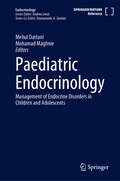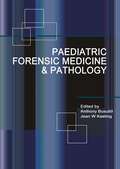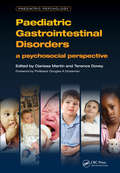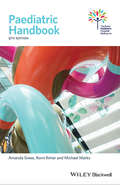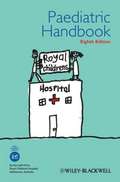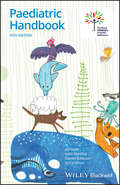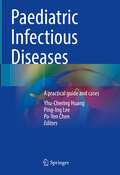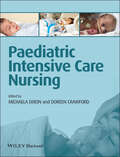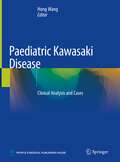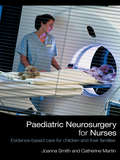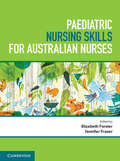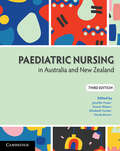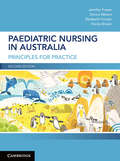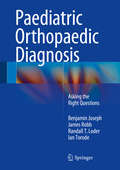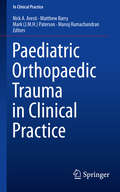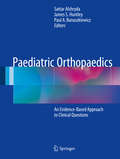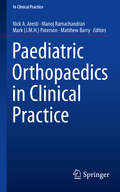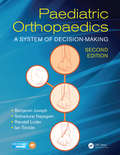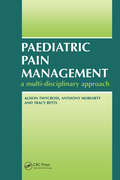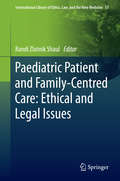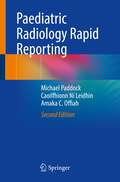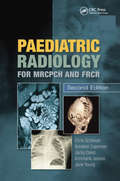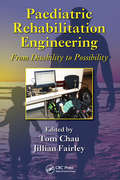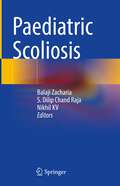- Table View
- List View
Paediatric Endocrinology: Management of Endocrine Disorders in Children and Adolescents (Endocrinology)
by Mehul Dattani Mohamad MaghniePediatric Endocrinology covers all of the main aspects of translational endocrinology and clinical practice, making it an ideal resource for both paediatricians and endocrinologists. The book emphasizes the newer translational aspects of the topics covered, as well as molecular advances in diagnosis and therapy, although clinical relevance, with a particular focus on evidence-based clinical management, remains paramount. Further, transitions from childhood to adolescence and adulthood are discussed wherever appropriate. Written by a combination of respected and emerging experts in the field, this book is intended to serve as a major reference work for pediatric endocrinologists at all stages of their careers, as well as general pediatricians with an interest in endocrinology and diabetes, and endocrinologists in adult practice who may also treat children and adolescents. The book is part of the SpringerReference program, which provides access to ‘living editions’ thatare constantly updated using a dynamic peer-review publishing process.
Paediatric Forensic Medicine and Pathology
by Anthony Busuttil Jean KeelingChild abuse and suspicious child deaths are very complicated matters for clinicians, pathologists, law enforcement officials and legal professionals to investigate. Meanwhile, the evidence base for forensic pathology, especially in paediatrics, is steadily growing.
Paediatric Gastrointestinal Disorders: A Psychosocial Perspective
by Clarissa MartinThe medical specialty of paediatric gastroenterology is focused on problems and disorders within the gastrointestinal tract, liver and pancreas of children from infancy until age eighteen. This inspirational compilation provides information on current research and clinical practice regarding the psychosocial aspects of paediatric gastrointestinal c
Paediatric Handbook
by Michael Marks Amanda Gwee Romi RimerThis new edition of the best-selling manual, The Royal Children's Hospital Melbourne Paediatric Handbook 9th Edition is a succinct and practical guide to managing common and serious disorders in childhood. Relevant to medical, nursing and allied health fields, this is both a useful source for revision and an essential guide to clinical management and rapid decision-making at the point of care. For this edition, the handbook has been restructured according to body systems and is now more closely aligned with the Royal Children's Hospital Clinical Practice Guidelines. It also includes updated evidence-based information in all chapters, an additional genetics chapter, new renal and oncology chapters and fully updated drug doses. The Handbook includes: Clear illustrations, and plenty of accessible diagnostic and management algorithms A Paediatric Pharmacopoeia Step-by-step guidelines for paediatric procedures Emphasis on the modern, community-based approach to the management of children's problems A strong emphasis on practical management by the doctor at first contact With well-presented, summarized information that you can easily access during a consultation, this text is also an excellent supplemental handbook for students, junior medical staff and medical practitioners.
Paediatric Handbook
by Mbbs Michael Marks Dean Tey Kate ThomsonThe Royal Children's Hospital, Melbourne is a leading clinical and training centre in paediatrics. This Handbook is a highly popular, succinct guide to managing common and serious disorders in childhood. It is used far beyond the hospital by medical, nursing, and allied health professionals caring for children. It emphasizes the community-based approach to the management of children's problems along with clinical management by the doctor of first contact. This new 8th edition has been updated in line with the Hospital's Clinical Practice Guidelines and features clear illustrations and diagnostic and management algorithms. The must have management guide for all paediatric clinicians and students With today’s busy clinician requiring an reliable, ‘one-stop-shop’ to questions on important paediatric conditions, who better to present the latest edition of a popular paediatric handbook than the team at The Royal Children’s Hospital, Melbourne, long-regarded as the leading clinical and training centre for Paediatric Medicine in Australia? Some of the exciting new features of the 8th edition include: • New chapters on sleep, continence, slow weight gain (failure to thrive) and obesity • Extensively revised chapters on renal conditions, pain management and immigrant health • New topics on continuous subcutaneous insulin infusion (pumps), cystic fibrosis, stroke and management of illicit drug poisoning • Links to useful internet websites are now included, indicated by a www symbol in the text margins • A new supplementary website at www.rchhandbook.org • Resuscitation guide and Australian Immunisation schedule on inside covers Besides being a clinical management guide to paediatrics, this is also an excellent supplemental handbook for students, junior medical staff and any medical practitioners needing a tool to enable fast decisions at point of care. Review of the previous edition “ This is an excellent handbook, which is most comprehensive and easy to use. It is highly recommended for all resident and registrar staff in paediatric hospitals and paediatric units. “ - Journal of Paediatric Child Health
Paediatric Handbook
by Nigel Curtis Mike StarrThe Royal Children's Hospital Melbourne Paediatric Handbook is a trusted guide to managing common and serious childhood illnesses and disorders. This bestselling resource provides students and practitioners across medical, nursing, and allied health fields with authoritative and up-to-date information on a comprehensive range of paediatric topics, enabling readers to make the appropriate decisions at the point of care. Now in its tenth edition, the Handbook features clear illustrations and evidence-based diagnostic and management algorithms throughout, covering resuscitation and medical emergencies, prescribing and therapeutics, medicine, surgery, procedures, and much more. Contains accessible summaries of common and serious paediatric illnesses and disorders Aligns with latest clinical practice guidelines Features numerous full-colour photos, illustrations, diagrams, and clinical images Provides practical guidance on professional ethics and communication in paediatric consultations Includes updated information on refugee health and trans and gender diverse health Paediatric Handbook is an invaluable reference for medical practitioners, nurses and allied health professionals, as well as students and trainees.
Paediatric Infectious Diseases: A practical guide and cases
by Yhu-Chering Huang Ping-Ing Lee Po-Yen Chen"This book aims to provide readers updated information on diagnosis and management of infectious diseases in children, especially those prevailing in Asian countries. Each chapter presents with one to two typical clinical cases first and then introduces the epidemiology, and the pearls of clinical skills in diagnosis and treatment of most frequent infectious pediatric diseases occurred in respiratory tract, gastrointestinal tract, central nervous system, bone/joint, skin and soft tissue . Infectious diseases in neonates, vaccine-associated adverse effects, and specific syndromes prevailing in Asian countries are also discussed with details. Written by experts in the field, this case-based book will be a useful reference for infectious disease researchers and paediatricians, as well as those who are interested in related field."
Paediatric Intensive Care Nursing
by Michaela Dixon Doreen CrawfordThe needs of critically ill children are unique and highly specialized. Paediatric Intensive Care Nursing is an essential manual of care and an invaluable resource to all those involved in the care of critically ill children and young people. Covering all the key aspects of pediatric intensive care, it is a fully comprehensive textbook which provides an evidence-based and up-to-date guide for all nurses who work with critically ill children.Paediatric Intensive Care Nursing is divided into four user-friendly sections:The first section looks at the general background of paediatric intensive careSection two employs a systems approach, with each chapter focusing on a specific disease and following the same framework. This includes treating children with cardiac conditions, acute neurological dysfunction, musculoskeletal injuries and gastrointestinal and endocrine conditionsSection three looks at the essential care of managing pain relief, transportation needs and treating woundsThe final section explores the holistic aspects of nursing - nutrition and fluid management, infection control issues, safeguarding children and spirituality and bereavementWritten by a team of experts in the field, Paediatric Intensive Care Nursing is indispensable reading for nurses and health care professionals working with critically ill children.
Paediatric Kawasaki Disease: Clinical Analysis and Cases
by Hong WangThis book introduces the clinical analysis and accompany cases of paediatric Kawasaki disease. It has 14 chapters about typical Kawasaki disease, atypical Kawasaki disease, recurrent, misdiagnosis, and complications involved different systems, such as cardiovascular, digestive, nervous, blood, respiratory, urinary, bone and joints, and endocrine systems complications. In this book, 53 Kawasaki cases are presented with clinical history, physical examination, laboratory findings, diagnosis, treatment and discussion. This book is helpful for clinicians, ultrasonologist, and radiologist to support early diagnosis and proper treatment, which can significantly improve the prognosis of Kawasaki disease.
Paediatric Neurosurgery for Nurses: Evidence-based care for children and their families
by Joanna Smith Catherine MartinPaediatric Neurosurgery for Nurses: Evidence-based care for children and their families provides accessible and up-to-date information for nurses working in paediatric neurosurgery. Referring throughout to the evidence-base for care and interventions, this complex area is described and explained in a meaningful and easily understandable way. The text includes chapters on the underpinning knowledge and principles for the care of children who need neurosurgery as well as the following common neurological problems: Hydrocephalus Traumatic Brain Injury Craniosynostosis Brain Tumours Surgical management of epilepsy in children Cerebrovascular disorders Neural tube defects The complexity of the nervous system and principles of care are presented logically with points to consider and essential care clearly highlighted and, where available, evidence-based practice is presented. It includes a range of pedagogical features, such as chapter overviews and summaries, diagrams, sample care plans, text boxes and a glossary. This book is essential reading for pre-registration nursing students and newly qualified nurses but will also be of use to allied healthcare professionals working with children and young people requiring neurosurgery.
Paediatric Nursing Skills for Australian Nurses
by Jennifer Fraser Elizabeth ForsterPaediatric Nursing Skills for Australian Nurses is the first Australia-focused, dedicated paediatric skills text for undergraduate students. Integrating the theoretical and clinical components of nursing knowledge, the authors outline the clinical skills needed in the care of children and young people. The journey begins with an introduction to communication - an essential skill for any paediatric nurse - before exploring crucial topics such as mental health, nutrition and medication. These discussions are presented in connection with the latest national competency standards for registered nurses to help equip readers with these necessary abilities. Pedagogical features include case studies, clinical tips and reflection questions to encourage active thinking and analysis of key concepts. Each chapter concludes with a set of review questions, a research topic and a list of recommended readings to consolidate student understanding. Paediatric Nursing Skills for Australian Nurses is an essential resource for pre-registered nurses within the Australian paediatric setting.
Paediatric Nursing in Australia
by Jennifer Fraser Jennifer Fraser Donna Waters Elizabeth Forster Nicola Brown Donna Waters Elizabeth ForsterFundamentals of Australian Paediatric Nursing equips students with the essential skills and knowledge to become paediatric, child and youth health nurses across a variety of clinical and community settings. It prepares students for critical thinking and problem solving within this field by emphasising contemporary issues impacting on the health of children, young people and their families. Written by a team of experienced paediatric nurses, the content is based on themes that align with Australian standards of competence and expectations of paediatric nursing: communication, family involvement and evidence-based practice. Comprehensive yet concise, the text examines the integration of theoretical and clinical components of nursing knowledge. To enhance learning, chapters feature case studies, reflection points and learning activities. An essential resource for nursing students, this text is grounded in current care delivery and professional issues for care of the child to prepare future nurses for evidence-based practice in paediatric settings throughout Australia.
Paediatric Nursing in Australia and New Zealand
by Jennifer Fraser Nicola Brown Donna Waters Elizabeth ForsterThe health of babies, children and young people is fundamentally different from that of adults, so their healthcare must reflect their unique needs and engage their parents, family members and communities. Paediatric Nursing in Australia and New Zealand introduces nursing students to the care of infants, children, young people and their families in a range of clinical and community settings across Australasia. This third edition includes New Zealand content and an increased focus on families. New chapters cover health services available for Aboriginal, Torres Strait Islander and Māori children, the transition to parenthood for new families, children's sleep patterns and behaviour, and paediatric health in school settings. Case studies and reflective questions encourage students to develop critical thinking and problem-solving skills. Written by an expert team, Paediatric Nursing in Australia and New Zealand equips future nurses with the knowledge and skills to provide evidence-based care to babies, children and their families.
Paediatric Nursing in Australia: Principles for Practice
by Jennifer Fraser Nicola Brown Donna Waters Elizabeth ForsterThe second edition of Paediatric Nursing in Australia: Principles for Practice brings the important care of the child and young person to life, by equipping students with essential knowledge and skills to become informed and capable partners in the nursing care of children, young people and their families across a variety of clinical and community settings. The text develops students' critical thinking and problem-solving skills by exploring contemporary issues impacting on the health of children, young people and their families. This new edition features the latest research and case studies, coupled with reflection points and learning activities in each chapter. Further resources, including links to video and web content, multiple-choice questions and critical-thinking problems, are available on the updated instructor companion website at www. cambridge. edu. au/academic/paediatricnursing. Written by a team of experienced nurses within the field, Paediatric Nursing in Australia: Principles for Practice, 2nd edition is grounded in current care delivery and is an essential resource in preparing future nurses for practice in paediatric settings throughout Australia.
Paediatric Orthopaedic Diagnosis
by Benjamin Joseph James Robb Randall T. Loder Ian TorodeThe book presents a problem-based, rational approach to the diagnosis of orthopaedic problems in children. It is divided into four sections based on the age at which specific problems may be encountered; the newborn and infant, the toddler and the pre-school child, the child in the school-going age and the adolescent. The authors outline a systematic approach to arrive at a tentative diagnosis by asking relevant questions related to the presenting symptom and then performing a thorough clinical examination. They then suggest the most appropriate investigations to confirm the diagnosis. Each chapter deals with the common conditions that may lead to the problem; the rarer causes of the problem are listed at the end. This feature would make the book a practical manual and a high quality reference source. An important feature of the book is the number and quality of illustrations and video clips in the electronic version.
Paediatric Orthopaedic Trauma in Clinical Practice
by Manoj Ramachandran Nick A. Aresti Matthew Barry Mark J. M. H. PatersonThis compact pocketbook provides orthopaedic surgeons in training with concise and relevant core knowledge on all aspects of children's fractures. Content includes the common fractures that affect children and "Red flags", such as the key management points of potentially serious injuries and complications. This book would also be useful to pediatricians and Accident & Emergency department doctors working in busy clinics that need a quick reference guide and with highlighted "red flags" of children's fractures. It is vital that anyone training in orthopaedics is well versed in the art and practice of orthopaedic trauma. Paediatric orthopaedic trauma presents its own unique challenges, from the assessment of the injured child (and management of the parents and extended family) through to intervention with minimal complication and follow-up for long-term complications. The aim of this book is to cover all the major aspects of paediatric orthopaedic trauma and to ease the passage through examinations, such as the FRCS(Orth), and busy on-calls, where common children's fractures are frequently encountered.
Paediatric Orthopaedics
by Paul A. Banaszkiewicz Sattar Alshryda James S. HuntleyThis book provides a refined clinical guide for evidence-based recommendations in paediatric orthopaedics. Focusing on specific body regions (hip, knees, ankle and feet, spine, shoulder, elbow and wrist and hand) this resource addresses clinical questions related to conditions in these areas. A background section in each chapter sets the scene for the best available practice and also appraises the evidence for its strength and weakness. At the end of each chapter, the authors' provide recommendations on future research. Evidence-Based Paediatric Orthopaedics: The Best Answers to Clinical Questions has been edited by a team of surgeons with a great interest in evidence-based practice who have brought together an international experts to produce this timely book. A wide spectrum audience including paediatric orthopaedic surgeons, trauma surgeons, orthopaedic residents, emergency department doctors, general practitioners and medical students looking for an evidence based approach to paediatric orthopaedics will find this book to be an essential guide for clinical practice.
Paediatric Orthopaedics in Clinical Practice
by Manoj Ramachandran Nick A. Aresti Matthew Barry Mark J. M. H. PatersonThis book provides orthopaedic surgeons in training with concise and relevant core knowledge on all aspects of children's orthopaedics. Content includes the common orthopaedic conditions that affect children, and key management points in each chapter are highlighted for readers to quickly access this information. The aim of this resource is to offer an authoritative guide on all facets of children's orthopaedics so the treating doctor has enough information to confidently allay the anxieties of the patient and their parents, and to identify when to refer the child to a paediatric orthopaedic surgeon. This book will be an essential reference guide for newly qualified orthopaedic specialists, as well as paediatricians and family doctors working in busy clinics that treat children who present with orthopaedic conditions.
Paediatric Orthopaedics: A System of Decision-Making, Second Edition
by Benjamin Joseph Ian Torode Selvadurai Nayagam Randall LoderUsing a multidisciplinary approach, Human Respiratory Viral Infections is set at the level between the definitive reference work and an essential clinical manual. Exploring recent advances in human respiratory viral research, the text builds on the basic sciences of epidemiology, virology, molecular biology, and immunology to cover clinical diagnosis, mechanism of pathogenesis, manifestations of disease, impact, treatment, and management strategies. <P><P> <li>Provides a comprehensive review of all the major human respiratory viral infections <li>Supplies a detailed description of the anatomy of the respiratory system <li>Discusses the salient features of specific viruses <li>Examines the latest diagnostic tools <li>Covers risk factors associated with incidence of respiratory viral infections in children and adults in different occupational and environmental settings <P><P>Presenting the latest knowledge in human respiratory viral infections, this text will be immensely valuable for pulmonologists, biomedical scientists, research scholars, virologists, vaccinologists, immunologists, clinicians, pharmacologists, and public health specialists.
Paediatric Pain Management: A Multi-Disciplinary Approach
by Alison Twycross Anthony Moriaty Tracey BettsChildren are still enduring unnecessary pain. This unique book is for all health care professionals who care for children, both in hospitals and in the community, and has contributions from nurses, doctors and clinical psychologists. It provides the theoretical knowledge required to manage acute and chronic paediatric pain, and discusses both drug and non-drug methods of pain relief. The information is presented in an accessible manner to enable readers to apply it in their daily clinical practice.
Paediatric Patient and Family-Centred Care: Ethical and Legal Issues
by Randi Zlotnik ShaulThis book provides the reader with a theoretical and practical understanding of two health care delivery models: the patient/child centred care and family-centred care. Both are fundamental to caring for children in healthcare organizations. The authors address their application in a variety of paediatric healthcare contexts, as well as an understanding of legal and ethical issues they raise. Each model is increasingly pursued as a vehicle for guiding the delivery of health care in the best interests of children. Such models of health care delivery shape health care policies, programs, facility design, resource allocation decisions and day-to-day interactions among patients, families, physicians and other health care professionals. To maximize the health and ethical benefits these models offer, there must be shared understanding of what the models entail, as well as the ethical and legal synergies and tensions they can create. This book is a valuable resource for paediatricians, nurses, trainees, graduate students, practitioners of ethics and health policy.
Paediatric Radiology Rapid Reporting
by Michael Paddock Amaka C. Offiah Caoilfhionn Ní LeidhinThere is a narrow margin between pass and fail in the notably demanding Rapid Reporting component of the Fellowship of the Royal College of Radiologists (FRCR) Part 2B examination. This book provides readers with a comprehensive evaluation of paediatric radiographs, not only for those preparing for this examination but for all those who report them in their clinical practice. The overriding principle remains the same regardless of background – safe radiographic interpretation. Prospective candidates may have only had limited opportunity to report paediatric imaging, which may have been some time before they attempt the examination. Whilst other resources provide only a limited selection of paediatric radiographs, this book is solely dedicated to improving skill and knowledge in paediatric reporting. This text has been meticulously crafted to bridge any gaps in knowledge, while addressing deficiencies repeatedly identified in the FRCR Part 2B Examiners’ Reports in that “many candidates struggle with interpretation of paediatric imaging—even for common paediatric pathologies” and that “knowledge of normal appearances on paediatric plain images…was particularly poor in the Rapid Reporting”. This new edition has been extensively revised and contains 3 new tests. This unrivalled educational resource now comprises nearly 400 practice paediatric radiographs which is unique to the marketplace. The range of cases, from neonate to adolescent, deliver a sound knowledge of common paediatric fracture patterns and pathologies which enables readers to confidently differentiate between normal and abnormal. The much-lauded explanations accompanying these high-quality imaging tests remain robust and accurate, allowing candidates to maximise their preparation for all facets of the FRCR 2B examination and beyond. Foreword by Professor Derek Roebuck
Paediatric Radiology for MRCPCH and FRCR, Second Edition
by Chris Schelvan; Annabel Copeman; Jacky Davis; Annmarie Jeanes; Jane YoungRadiology plays a fundamental role in the diagnosis and management of childhood diseases. This is reflected in both paediatric and radiology post graduate exams, where candidates are expected to have a working knowledge of paediatric pathology, clinical manifestations and appropriate radiological investigations. Building on the great success of the first edition, Paediatric Radiology for MRCPCH and FRCR retains the popular preexisting structure of the book, but presents an improved variety of clinical cases as well as updated text in-keeping with advances in medical practice and technology. There is more emphasis on cross-sectional imaging, as candidates are increasingly encountering these sophisticated imaging tests in postgraduate exams. Images have been updated, and all the clinical information has been reviewed and revised accordingly.Contains over 100 clinical cases, presented in exam format, with answers overleaf Includes a wide range of common and rare paediatric conditions with supplementary images to illustrate additional points Uses classic examination images, with salient radiological and clinical summaries of each condition - the "hot lists" Carries specific information for paediatricians and radiologists for each case An introductory chapter on the basic concepts of imaging aims to provide the reader with an approach to radiological imaging and an awareness of the different modalities available, with new sections on non-accidental injury and radiation protection.
Paediatric Rehabilitation Engineering: From Disability to Possibility (Rehabilitation Science in Practice Series)
by Tom Chau Jillian FairleyInnovations in paediatric rehabilitation engineering can serve as a springboard to education, psychosocial, social, physical and cognitive development for children and youth with disabilities. Instead of providing an overview of rehabilitation engineering, Paediatric Rehabilitation Engineering focuses on the uniqueness of the paediatric subspecialt
Paediatric Scoliosis
by Balaji Zacharia S. Dilip Chand Raja Nikhil KvThe understanding of Pediatric scoliosis has evolved over decades of research, and significant advancements have been achieved in managing the multiple types of scoliotic deformities. This book provides comprehensive information on etiopathogenesis, evaluation, and management of scoliosis along with the latest technological advances. This book is also an invaluable and practical tool providing critical information on the rationale behind the several classification systems of scoliosis. This book, authored by reputed Indian Spine surgeons and renowned international scoliosis experts, focuses on the current treatment algorithms based on the etiology and natural history of the disease and simplifies the decision-making process in managing scoliosis in children. We have included sections that describe various corrective maneuvers, surgical techniques, expected complications, and tips and tricks to avoid them. This book will serve as an essential guide for all orthopedic and neurosurgery trainees and residents and provides updates for experienced surgeons on recent advancements in surgical techniques.
